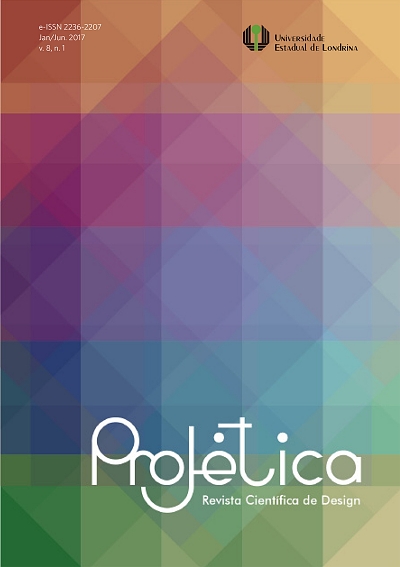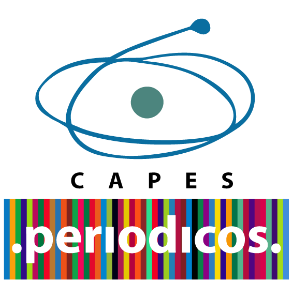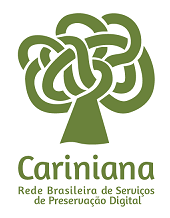Folding practice: how the origami paradigm mediates the search for knowledge, innovation and contemporary design
DOI:
https://doi.org/10.5433/2236-2207.2017v8n1p29Keywords:
Origami, Design, Product, Contemporary.Abstract
This research aims to understand the potential of origami creative process through experimental exploration and by analyzing some projects developed in different areas. Josef Albers and Ron Resch’s academic careers and methods on the practice of folding are the main focus in this study. Within the applied design, an analysis is conducted on the projects Origami Heart Stent, Ori-Revo and Evolution Door.Downloads
References
BONSIEPE, G. Design, cultura e sociedade. São Paulo: Blucher, 2011.
DELEUZE, G. A dobra: Leibniz e o barroco. Tradução de Luiz B. T. Orlandi. Campinas: Papirus, 1991.
DEMAINE, E. D. et al. A review on curved creases in art, design and mathematics. Symmetry: Culture and Science, Hungria, v. 26, n. 2, p. 145-161, July 2015.
DEMAINE, E. D. et al. Programmable matter by folding. Proceedings of The National Academy of Sciences of the United States of America, Washington, v. 107, n. 28, p. 12441-12445, July 2010.
FLUSSER, V. O mundo codificado: por uma filosofia do design e da comunicação. Tradução de Raquel Abi-Sâmara. São Paulo: Cosac Naify, 2007.
FRANCIS, K. C. et al. From crease pattern to product: considerations to engineering origami-adapted designs. In: INTERNATIONAL DESIGN ENGINEERING TECHNICAL, CONFERENCES AND COMPUTERS AND INFORMATION IN ENGINEERING CONFERENCE, 2014, Buffalo. Proceedings … Buffalo: The American Society of Mechanical Engineers, 2014. p. 1-15. Disponível em: http://proceedings.asmedigitalcollection.asme.org/proceedingbrowse.aspx#Year. Acesso em: 11 abr. 2016.
FREDERICKSON, G. N. Hinged dissections: swinging & twisting. Cambridge: Cambridge University Press, 2002.
HYDE, R. et al. Eyeglass: a very large aperture diffractive space telescope. In: SPIE HIGHLY INNOVATIVE SPACE TELESCOPE CONCEPTS, 2002, Washington. Proceedings … Washington: SPIE The International Society for Optics and Photonics, 2002. p. 28-39.
KOMIYAMA, M. et al. Nanomechanical DNA origami ‘single-molecule beacons’ directly imaged by atomic force microscopy. Nature, Londres, v. 2, n. 44, p. 1-8, 2011. Disponível em: http://www.nature.com/ncomms/journal/v2/n8/full/ ncomms1452.html. Acesso em: 11 abr. 2016.
KURIBAYASHI, K.; YOU, Z. A novel origami stent. In: SUMMER BIOENGINEERING CONFERENCE, 2003, Florida. Anais... Florida: Tulane University, 2003. Disponível em: http://www.tulane.edu/~sbc2003/pdfdocs/0257.PDF. Acesso em: 25 maio 2015.
KURIBAYASHI, K.; YOU, Z. Expandable tubes with negative poisson’s ratio and their application in medicine. In: ORIGAMI, INTERNATIONAL MEETING OF ORIGAMI SCIENCE, MATHEMATICS, AND EDUCATION, 4., 2006, Massachusetts. Proceedings … Massachusetts: A K Peters, 2009.
LANG, R. J. Origami 4: fourth international meeting of origami science, mathematics, and education. Massachusetts: A K Peters, 2009.
LANG, R. J. Origami design secrets: mathematical methods for na ancient art. 2. ed. Massachusetts: A K Peters, 2003.
LANG, R. J.; IVERSON, P. W.; YIM, M. Origami 5: fifth international meeting of origami science, mathematics, and education. Massachusetts: A K Peters, 2011.
MENGES, A. Fusing the computational and the physical: towards a novel material culture. Architectural Design, São Francisco, v. 85, n. 5, p. 8-15, 2015. Disponível em: http://onlinelibrary.wiley.com/doi/10.1002/ad.2015.85.issue-5/issuetoc. Acesso em: 11 nov. 2015.
MITANI, J. A design method for 3D origami based on rotationalsweep. Computer-Aided Design and Applications, Bangkok, v. 6, n. 1, p. 69-79, 2009. Disponível em: http://mitani.cs.tsukuba.ac.jp/dl/CAD_2009_3d_origami_based_on_rotational_sweep_mitani.pdf. Acesso em: 31 maio 2015.
MORGAN, M. R. et al. Towards developing product applications of thick origami using the offset panel technique. Mechanical Sciences, Elmsford, v. 7, n. 1, p. 69-77, mar. 2016. Disponível em: http://www.mech-sci.net/7/69/2016/ms-7-69-2016.html. Acesso em: 2 abr. 2016.
RESCH Ron; ARMSTRONG, Elmer. The Ron Resch paper and stick film Direção de Ronald D. Resch. Salt Lake City, UT : Resch Films, ©1992.
Vídeo em VHS. sound, color ; 1/2 in. Disponível em: https://vimeo.com/36122966. Acesso em: 28 jun. 2016.
RESCH, R. D. Construction-element. US4397902 A, 27 dez. 1977, 9 ago. 1983. Disponível em: https://www.google.com/patents/US4397902. Acesso em: 28 jun. 2016.
RON RESH OFFICIAL WEBSITE. The Works of Ron Resch. 2016. Disponível em: http://www.ronresch.org/ronresch/. Acesso em: 28 jun. 2016.
ROTHEMUND, P. W. K. Folding DNA to create nanoscale shapes and patterns. Nature, Londres, v. 440, n. 7082, p. 297-302, 2006. Disponível em: http://www.nature.com/nature/journal/v440/n7082/full/nature04586.html. Acesso em: 11 abr. 2016.
STEWART, I. Some assembly needed. Nature, Londres, v. 448, p. 419-419, jul. 2007.
TORGGLER, K. The evolution door. Viena: [s.n.], 2015. Disponível em: http://www.torggler.co.at/. Acesso em: 11 nov. 2015.
WEB OF SCIENCE. Base de dados online. Thomson Reuters, 2016. Disponível em: http://apps.webofknowledge.
com/CitationReport.do?product=UA&search_mode=CitationReport&SID=3Dq7oUiuM3QZLe88YcE&page=1&cr_pqid=1&viewType=summary. Acesso em: 1 fev. 2016.
Downloads
Published
How to Cite
Issue
Section
License
Projética está licenciada sob a Creative Commons Attribution CC-BY 4.0 International. Os autores detém os direitos autorais e concedem à revista o direito de exclusividade de primeira publicação.
Os autores dos trabalhos aprovados autorizam Projética a, após a publicação, ceder seu conteúdo para reprodução em indexadores de conteúdo, bibliotecas virtuais e similares.
Os autores assumem que os textos submetidos à publicação são de sua criação original, responsabilizando-se inteiramente por seu conteúdo em caso de eventual impugnação por parte de terceiros. As opiniões emitidas pelos autores dos artigos são de sua exclusiva responsabilidade.
A revista se reserva o direito de efetuar, nos originais, alterações de ordem normativa, ortográfica e gramatical, com vistas a manter o padrão culto da língua e a credibilidade do veículo. Respeitará, no entanto, o estilo de escrever dos autores. Alterações, correções ou sugestões de ordem conceitual serão encaminhadas aos autores, quando necessário. Nesses casos, os artigos, depois de adequados, deverão ser submetidos a nova apreciação. As provas finais não serão encaminhadas aos autores.











